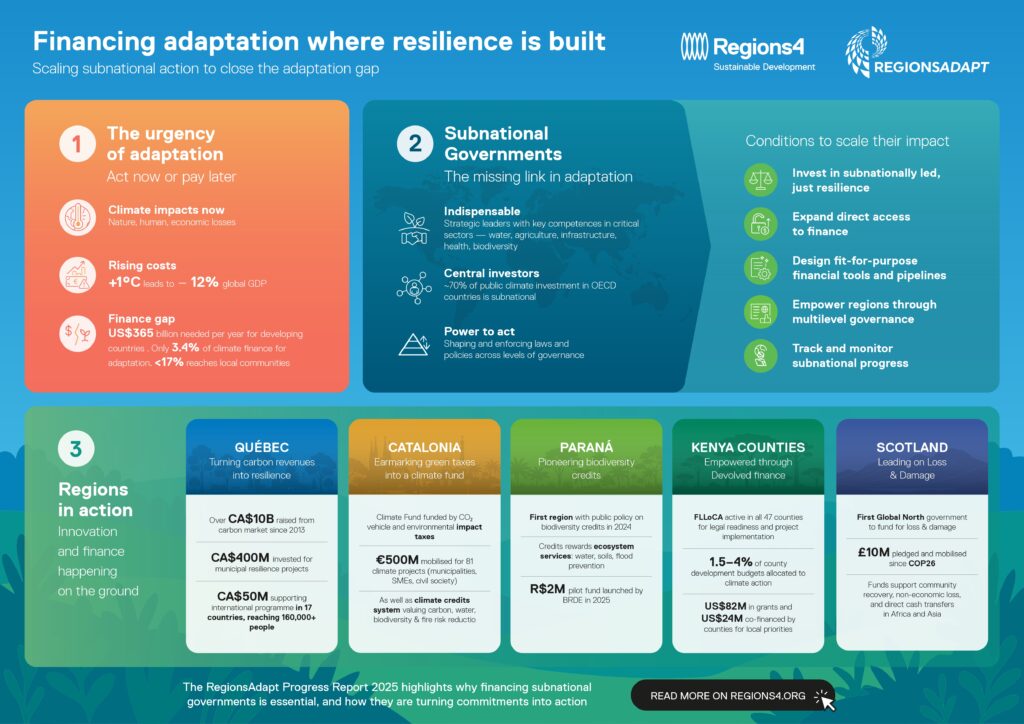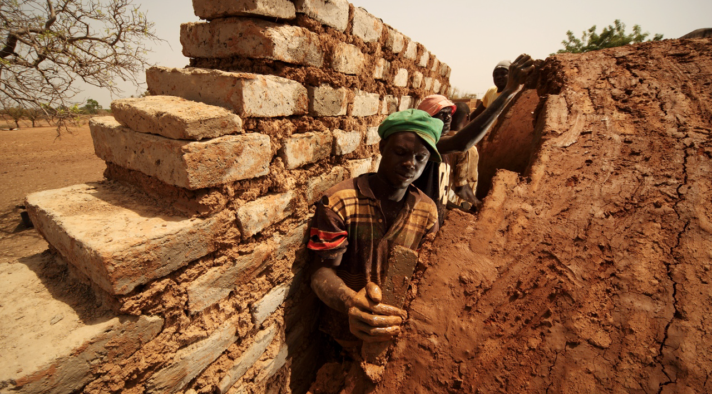Financing Resilience Where Change Happens: Scaling Subnational Finance Now
As global climate impacts intensify, adaptation remains dramatically under-funded — while regional governments increasingly shoulder the responsibility for resilience on the ground. On November 11, 2025, the RegionsAdapt Progress Report 2025 will be launched, offering an in-depth look at where regions stand today on adaptation finance — the challenges they continue to face, the solutions they are already implementing to fund climate-resilient territories, and the key recommendations to scale up action and investment where resilience is built.
RegionsAdapt, Regions4’s flagship climate initiative, supports regional governments in implementing climate change adaptation strategies since 2015. Pioneering collaboration among leading regions, it boasts 80+ signatory members, impacting over 300 million citizens, mobilizing global efforts in climate adaptation.
Explore the Key Findings at a Glance
To visualise the report’s main insights — from the scale of the adaptation finance gap to the leadership of regions worldwide — explore the RegionsAdapt 2025 infographic below.

Regions as the Missing Link in Climate Finance
Subnational governments — regions, provinces, states — manage the infrastructure, land use, water, health, rural and urban systems where climate impacts are already manifest. They operate at the interface of global ambition and local delivery.
Yet international adaptation finance continues to flow primarily via national channels, limiting regional access, constraining innovation, and reducing the scale of what is possible on the ground.
This report reveals three dynamics:
- Regions are already acting — scaling municipal efforts, shaping cross-sectoral adaptation, mobilising their own-source revenues.
- Structural barriers persist in some regions — weak mandates, low creditworthiness, data/monitoring deficits, and project preparation bottlenecks .
- Scaling requires system change — dedicated windows for subnational access, institutionalised multilevel governance, project-prep ecosystems and transparency in tracking flows.
Innovation is Happening. Now It Must Be Powered Up.

Drawing insights from 40 reporting RegionsAdapt members, the report presents 12 compelling case studies that demonstrate how strategies addressing both biodiversity and climate adaptation can drive effective solutions. From ecosystem restoration to nature-positive urban planning, these stories illustrate how integrating biodiversity into climate adaptation can yield positive outcomes for both nature and communities.
- Québec’s carbon-revenues model: CA$400 million+ directed to adaptation and resilience.
- Catalonia’s Climate Fund: over €500 million invested in 81 projects since 2021.
- Andalusia’s green-budget tagging: €1.17 billion of its 2023 budget allocated to climate-relevant spending.
- Kenya’s FLOCCA programme: devolving climate finance to 47 counties through a performance-based model.
- Paraná’s ecological fiscal transfers: R$10 billion redistributed to municipalities, safeguarding 4+ million ha of forests and water reserves.
- São Paulo, Basque Country, Pastaza & Zamora Chinchipe, Gauteng: all proving that regions can innovate — when empowered.

Several stories from the RegionsAdapt Progress Report are also featured in our Case Study Database and our RegionsVoice campaign. Discover a selection of these stories below, and visit the full RegionsVoice campaign page to explore them all.
A Call to Action for COP30 and Beyond
To translate regional readiness into scaled action, COP30 must deliver three critical system shifts:
- Institutionalise subnational roles: Embed regional governments within NDCs, NAPs and national adaptation strategies — recognise them as full partners, not just implementers.
- Expand direct access: Create dedicated adaptation-finance windows for subnational governments; simplify procedures and fit finance to regional realities.
- Build project-prep ecosystems: Fund early stage design, risk assessment, capacity-building, data/monitoring and pipeline development — so adaptation becomes bankable and scalable.
- Track subnational flows: Ensure transparency, disaggregation and accountability — so finance matches risk and need, and so subnational action is visible and valued.
- Invest in just, nature-positive resilience: Adaptation must centre people, equity, indigenous knowledge, ecosystem functions and biodiversity — not just infrastructure.
Access the report
The RegionsAdapt Progress Report 2025 highlights our collective effort to build a future that not only addresses the challenges of climate change but also confronts the biodiversity crisis head-on.
Download the report after its release on November 11th, to explore the inspiring stories within, and join us on the journey to create a resilient world that benefits both people and nature.
With the support of




